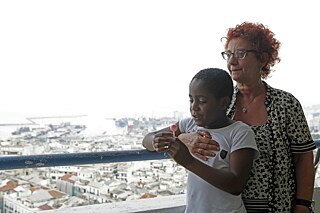I studied in Algeria, and I started to work there, but it was frustrating. You have a job, a salary, but no real responsibilities - especially if you are a young woman. I started asking myself questions about society. A privileged class had established itself and the needs of everyone were not taken into account.
In spite of this, I lived there, I had no intention of leaving. In 1989 I moved to France to do a PhD and be with the man I loved. But for me, this was not a permanent move.
I stayed in France for 20 years. I had to adapt to this society, based on the individual and not the collective. This was the making of my professional career. Even though I was young, I was given a chance and I was really able to work. I worked on human rights with Amnesty International France, and I rediscovered this international solidarity which had so strongly influenced my childhood. But I no longer liked living in France, in this individual liberal society. Amnesty had a position open in Algeria. I also wanted to once more experience my family environment. So I returned to Algeria.
I relaunched the Algerian division of Amnesty thanks to the active participation of young people. There was so much to do! I discovered the dynamism of the youth, who were so involved in so many areas of human rights. They had few means but showed so much creativity, in a society in crisis. Unfortunately, the State didn’t participate.
I wanted to adopt a child for a long time. I met Fayçal, who would become my son, in a nursery near Algiers. He was already 3 years old. “We can’t find a home for him”, they said to me, “because of the colour of his skin”. I was truly shocked. The paperwork took quite a while, but I was finally able to adopt him.
Based on that event, I discovered the question of colour in Algeria. Firstly, Fayçal had difficulty with the fact that he was black. In a blink of an eye, he knew if a person was black or not. My husband is from Guadeloupe, so it was obvious for Fayçal that his father was black. And at first, he thought that this was a bad thing. Then one day, he asked me: “But do you love me really, even if I’m Kahlouch?”
It’s difficult to be stared at by people on the street. Many think we are foreigners, sometimes they even speak to us in English. They are confused when Fayçal speaks with an Arab dialect... they can’t even understand that he’s Algerian.
Ever since nursery, everywhere he goes he’s often the only black child. One, in a store he embraced another black child. They hugged each other like friends, even though they didn’t know each other!
One day, a boy pushed him in the street and said to him: “Kahlouch!” His mother, annoyed, said: “machi Kahlouch, houwa marron” (he’s not black, he’s brown!). I responded that he was black and that was all!
Children insult each other all the time, but I explained that “Kahlouch” is racist! So we tried to promote the idea of being black. Obama helped us a lot! We also went to France and in Barbès in Paris he saw a large number of black Africans for the first time. Now he felt less isolated. There were three African-American children in his new school.
Recently, in the street, I saw migrants panicking, running with their children. Police vehicles were arriving, and they were afraid of being expelled. Fayçal had gone out to play sport, and I was afraid that they would arrest him. I went to look for him, and I was so happy to see his face! Now I let him go alone, but I tell him to be sure to say that he is Algerian, that his mother works for Amnesty, and I make him repeat the address.
If you’d asked me 15 years ago if there was racism in Algeria, I’d have replied “no”. I was in denial, like many Algerians. Today, when I denounce racism in Algeria, people are shocked, but at least there is a debate. Some Algerians are starting to take pride in their African roots. Black Algerians are not sufficiently represented in society, and it’s still taboo to marry a black person. Sometimes I am asked from which African country Fayçal comes from...well Algeria, of course! It’s an African country!
The pan-African Algeria in which I grew up was an Algeria which my father dreamed of, which he passed on to me and for which we must continue to struggle.
Photographer Leïla Saadna
Leïla Saadna is a visual artist and a director of documentary films. She has been living and working in Algiers for two years. After studying plastic arts in Paris, she oriented herself towards engaged and poetic film and artistic projects. Her working and research themes are post-colonial migration stories, the words and struggles of people affected by intersectional forms of oppression, such as racism and sexism, and in particular the experiences of women in a post-colonial context.
September 2018
